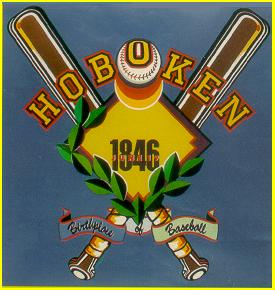 |
 Hoboken and the Beginnings of Baseball
Hoboken and the Beginnings of Baseball
By Nicholas Acocella
Part 3b - The Cartwright Rules (2)
What Cartwright didn't do is equally instructive. He did not specify nine men to a side. From accounts of games, however, we know that nine to a side was the norm; in a game played in May 1847, for instance, the Knickerbockers had 22 players available, but chose to field only nine on each side, and to keep two players on each team as reserves. But nine to a side was a norm, not a requirement, and deviation from the custom was common. Aside from those of the pitcher and catcher, the positioning of the nine players would be unfamiliar to a modern fan. Basemen stood directly on their respective bases, there was no shortstop, and there were four outfielders.
His definition of a game was not nine innings, but "twenty-one counts, or aces," that is, 21 runs. An 1857 convention of amateur ballplayers overturned this primitive solution by giving approval to the inspired perception that a baseball game ends, not when one or the other team scores 21 runs, but after nine innings -- with extras only to evade the abhorrent vacuum of a tie. No one, however, has ever tampered with the Cartwright-ordained right to last licks for the team that is losing.
He required that "the ball must be pitched, and not thrown, for the bat." Since Base Ball was deemed to be about hitting and fielding rather than pitching, the feeder (or pitcher) had to lay the ball in underhand and within easy reach of the batter. The 1857 rules established the distance between home plate and the pitcher's location at 45 feet, probably formalizing what had been custom. In 1893, after a brief experiment with a 50-foot distance, the pitching distance was set at the current 60 feet, six inches.
He allowed but did not insist on catching the ball on the fly; grabbing it on one bounce was good enough for an out. As early as 1859, the Knickerbockers adopted the "fly game" for intramural contests. At their insistence, but only after years of debate on the issue, the National Association of Base Ball Players decreed in 1860 that, to record an out, a fielder had to catch a batted ball before it bounced, and, until 1865, only if both teams agreed beforehand.
He eliminated "soaking" but did not create the force out. Instead, he replaced it with two possibilities. One was the tag-out; the other a sort of proto-force out that allowed a fielder to record an out by holding the ball and standing on the base toward which a runner was headed. (Little wonder, then, that the basemen stayed put on their respective bases.) An 1848 revision allowed such putouts only at first base, a refinement still in effect; and it left the team in the field with only the tag-out option at other bases -- even when there were runners on preceding bases. The force out, which allows a fielder in the example above to record an out merely by stepping on the bag with the ball in his possession, has often mistakenly been included among Cartwright's innovations. It was not introduced, however, until 1854.
He defined what was, in effect, a ground rule single, a rule that no longer exists, although the modern rule book does provide for the ground rule double.



|
|
 |